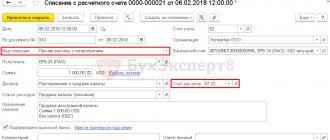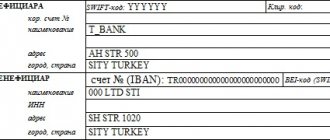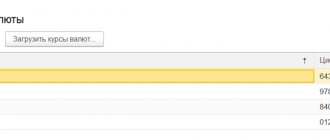Foreign exchange transactions can sometimes be a nightmare.
Obviously, when one company trades with a foreign company, their currencies are different and their exchange rates are constantly changing.
How to correctly account for advance payments in foreign currency according to IFRS? How can we take into account the impact of changes in exchange rates?
The answers to these questions depend on a number of factors, especially the nature of the specific prepayment. Let's look at two different scenarios for illustration.
What do the standards require?
IAS 21 The Effects of Changes in Foreign Exchange Rates provides rules for converting an amount into another currency in two cases:
- Converting the amount in a foreign currency into your functional currency;
- Translation of a transaction presented in the financial statements into the presentation currency.
When you record foreign currency transactions during the year, you translate the amounts denominated in the foreign currency into your functional currency.
Let us briefly recall what IAS 21 prescribes:
1. On initial accounting, you must translate all foreign currency amounts into your functional currency at the exchange rate in effect on the date of the transaction. [cm. paragraph IAS 21:21]
2. Subsequently (that is, after initial recognition), at each period-end close you must restate:
- All cash in foreign currency at the exchange rate at the reporting date;
- All non-monetary items in foreign currencies that are measured at historical cost—at the exchange rate on the date of the transaction;
- All non-monetary items denominated in a foreign currency that are measured at fair value using the exchange rate at the date of fair value measurement.
[cm. paragraph IAS 21:23]
To clarify the prepayment issue, the IASB issued IFRIC 22 Foreign Currency Transactions and Prepayments in 2016, which basically confirms that for exchange rate purposes, the transaction date is the date of initial recognition of the non-monetary asset or non-monetary liability arising as a result of making or receiving advance payment.
There are two important aspects of assessment:
- Transaction date;
- Nature of prepayment.
Transaction date.
It is clear that you should initially use the spot exchange rate on the transaction date for conversion.
But what is the date of the operation?
This is the date on which a transaction initially qualifies for recognition in accordance with IFRS.
Of course, this principle applies differently to different accounting objects, for example:
- For financial obligations : when a company becomes a party under the terms of a valid contract;
- For property, plant and equipment : when it is probable that future economic benefits from the asset will flow to the entity and the costs can be estimated reliably.
Although this sounds quite simple, there may be some difficulties in determining the date of the operation.
For example, you receive goods on day 1, an invoice for these goods on day 3, and pay for these goods on day 4. What will be the transaction date in this case? Which exchange rate should I apply on day 1, 3 or 4?
Let's look at this in our example below.
Nature of prepayment.
In relation to subsequent translation at the reporting date exchange rate, IAS 21 makes a distinction between monetary items and non-monetary items:
- Monetary items are translated using exchange rates;
- Non-monetary items are NOT restated but are recorded at original or historical rates.
Is the prepayment for your fixed asset monetary or non-monetary? It can be either a monetary or non-monetary item!
There is one more thing that matters:
The right to receive or the obligation to provide a fixed or determinable quantity of currency units.
Prepayments as such may serve or carry this function and you should evaluate each prepayment individually and carefully with this in mind.
Read the specific contract - what does it say about prepayment?
Is there a refund for your prepayment and under what conditions?
If there is a clause in the contract about refunding your deposit - what is the likelihood of this happening?
In most cases (in Western practice), prepayments made towards the purchase of fixed assets or any goods/services in general are rarely refundable, or the likelihood of this is very low.
Therefore, your down payment on the car (in most cases) is a non-monetary item and, as a result, you should NOT restate it using the rate at the balance sheet date.
The following example will show how to account for a down payment for the purchase of a vehicle if it is classified as a non-monetary asset.
Example 1. Advance payment for the purchase of a car.
Your functional currency is EUR, and you have contracted to manufacture a machine with a US supplier.
The total cost of the car is $100,000, and you have agreed to pay this amount in 2 installments:
- 1st payment: $30,000 after signing the contract;
- 2nd payment: $70,000 after delivery of the machine.
The corresponding event dates and exchange rates are shown in the table:
| date | Event | Exchange rate |
| 4 February 20×7 | Agreement signed | 1.3552 |
| 11 February 20×7 | Advance payment made | 1.3391 |
| 31 December 20×7 | Reporting date | 1.3791 |
| January 15 20×8 | Delivery of the machine and transfer of ownership | 1.3606 |
| January 20 20×8 | Invoice received | 1.3566 |
| February 2 20×8 | Invoice paid | 1.3498 |
How and when should these transactions be accounted for?
February 4, 20×7: agreement signed.
On 4 February you entered into a contract, but no asset can be recognized in accordance with IAS 16 Property, Plant and Equipment because the recognition criteria are not met.
[cm. See also full text of IAS 16]
Likewise, you need to evaluate whether you should recognize any financial liability or not.
In most cases, a financial liability associated with firm liability is not recognized until the goods are delivered (or shipped, depending on Incoterms) and the risks and rewards of ownership have transferred.
Conclusion: The event is not recorded on 4 February 20X1.
February 11, 20×7: Down payment of $30,000 made.
As of February 11, the machine recognition criteria under IAS 16 are still not met.
Remember that you don't have a car yet.
At the moment you cannot dispose of the car, and as a result.
Some companies use this practice: they simply post a prepaid payment to the debit of the Fixed Assets account, crediting the cash account. This is NOT correct , since the company does not have a car yet.
So what is the correct entry for February 11th?
Debit. Assets - prepayment for fixed assets: 22,403 euros ($30,000 / 1.3391).
Credit. Cash: €22,403.
In practice, you will determine the conversion rate depending on the circumstances. If you paid $30,000 from an account to:
- EUR - you use the rate at which your bank recalculated the transaction;
- USD - You apply official exchange rates. For example. rate of the European Central Bank.
31 December 20×7: reporting date.
In this case, the $30,000 down payment for the car is non-monetary.
This means you don't have to recalculate it. Your statement of financial position shows the prepayment at the historical rate, which is €22,403.
January 15, 20×8: delivery of the machine and transfer of ownership.
This is the exact date when you take control of the car. At this point, the recognition criteria under IAS 16 are met and you can recognize the machine as your own property, plant and equipment.
However, subsequently, on January 20, 20×8, an invoice was issued for the remaining cost of the car in the amount of $70,000.
What exchange rate should be applied?
On the date of the transaction.
In this case, the date of the operation is January 15. That is, the date on which the machine was delivered and the delivery gave rise to a financial liability.
As a result, your wiring should be like this:
Debit. Assets - car (OS): 51,448 euros ($70,000 / 1.3606).
Credit. Accounts payable - suppliers: EUR 51,448.
This is a very strict application of IAS 21 rules. Let's try to apply them a little more practically.
It may be acceptable to apply the exchange rate to the invoice date rather than the machine delivery date, especially if there is a slight delay in the invoice.
However, if there are some significant changes in the foreign exchange markets, you must adhere to the delivery date of the machine.
January 15, 20×8: What about your advance payment?
At the delivery date, you need to recognize the machine and estimate its cost.
Part of the cost of the car is an advance payment paid after signing the contract. The cost of a car is also a non-monetary item - it is not recalculated and is taken into account at the historical rate.
So you don't recalculate anything and your wiring will be like this:
Debit. Assets - car (OS): 22,403 euros.
Credit. Assets - prepayment for OS: 22,403 euros.
Here you might object - the date the machine appears on the financial statements is the delivery date, so we must convert the total cost of the machine to $100,000 at the delivery date exchange rate.
Some companies take this approach, but it is not entirely correct and represents a judgment about the fair amount of the transaction.
The real point is that when the machine is delivered, the asset recognition criteria are met and you need to recognize the machine in its entirety as one item of property, plant and equipment.
But estimating its value is another matter.
Your actual cost is:
- $30,000, translated at the exchange rate on the date of the first payment and
- $70,000, translated using the exchange rate at the delivery date.
It should be understood that at the time of delivery, the $30,000 prepayment is no longer a dollar asset. This is your asset in euros. Why?
Try to look at it this way: most non-monetary assets cease to be “foreign currency” assets the moment you recognize them in your functional currency accounts.
So you don't have an asset (prepayment) of $30,000 on your books - instead you have an asset of €22,403.
February 2, 20×8: payment of invoice.
Everything should be completely clear here. You record your payment using the spot exchange rate on the payment date and any exchange rate difference is recognized in the income statement.
Your wiring will be like this:
Debit. Accounts payable - suppliers: €51,448 ($70,000 / 1.3606).
Credit. Cash: 51,860 euros.
Debit. Profit/loss - exchange rate losses: 412 euros (51,860 - 51,448).
A summary of all the operations described above is given in the table:
| Operation | Amount in USD | Well | Amount in EUR | Debit | Credit |
| February 11, 20×7 — Prepayment | 30 000 | 1,3391 | 22 403 | Assets - prepayment for OS | Cash (bank account) |
| January 15, 20×8 — Machine delivery | 70 000 | 1,3606 | 51 448 | Assets - machine (OS) | Accounts payable - suppliers |
| — | — | 22 403 | Assets - machine (OS) | Assets - prepayment for OS | |
| February 2, 20×8 – Payment of invoice | 70 000 | 1.3498 | 51 860 | Cash (bank account) | |
| — | — | 51 448 | Accounts payable - suppliers | ||
| — | — | 412 | Profit / loss - loss from exchange rate differences |
Sales of goods in USD in 1C: Enterprise Accounting ed. 3.0
Published 12/13/2021 07:06 Author: Administrator The topic of calculations in conventional units is complex and relevant at all times. So let's continue talking about this. In this publication we will look at several examples of contracts for the sale of goods in monetary units. in 1C: Enterprise Accounting ed. 3.0 with different terms of payment and shipment of goods: shipment on the terms of 100% prepayment, partial prepayment (advance payment), shipment and payment of the remaining balance of the debt; deposit, advance payment, shipment and payment of the remaining debt; full payment after shipment of the goods (postpayment).
The peculiarity of such an agreement is that at the time of its signing by the parties to the transaction, the final price of the agreement in rubles is unknown and can be determined only at the moment of fixing the exchange rate established by the agreement. The cost of the goods must be paid in rubles in an amount equal to a certain amount. according to the agreement, at the official exchange rate of the currency the equivalent of which is cu, on the day of payment (clause 2 of Article 317 of the Civil Code of the Russian Federation). Also, the contract may establish a different rate or a different date for its determination by agreement of the parties.
Sales of goods under a contract in USD subject to 100% prepayment
In the first example, we will consider the implementation under a contract in monetary units. subject to 100% prepayment. If the buyer has made an advance payment of 100%, the entire cost of the goods, expressed in cu, is recalculated into rubles at the Bank of Russia exchange rate in effect on the date of payment, or another rate established by the agreement (paragraph 2, clause 9 of PBU 3/2006, clause 10 of article 272 of the Tax Code of the Russian Federation).
Vasilek LLC and Beta LLC entered into an agreement for the supply of agricultural equipment, namely the Case AF150 grain harvester, with the following conditions:
1. Product cost 300,000.00 USD;
2. The buyer must make a 100% prepayment for the goods in the amount of 300,000.00 USD no later than 04/01/2021.
3. The goods must be shipped to the buyer no later than 5 calendar days from the date of receipt of the advance payment by the supplier.
04/01/2021 Beta LLC transferred funds in the amount of 300,000.00 USD x 75.6373 = 22,691,190.00 rubles to the supplier Vasilek LLC:
On 04/05/2021, the supplier sold goods in the program to the buyer Beta LLC in the amount of 300,000.00 USD x 75.6373 = 22,691,190.00 rubles at the prepayment rate as of 04/01/2021:
Let's check the calculation of the ruble amount according to the document using the calculation certificate:
As we can see from the calculation certificate, the ruble sales amount is equal to the ruble amount of 100% prepayment. In this situation, no exchange rate differences arise, since there are no receivables.
Sales of goods under a contract in USD subject to partial prepayment (advance payment) and payment after shipment of the goods
In the second example, we will consider a situation where the terms of the contract provide for partial prepayment (advance payment), shipment of goods and payment after shipment of goods.
When the buyer transfers an advance payment, the cost of the goods is calculated as follows: in the part paid in advance - at the Bank of Russia exchange rate on the date of payment of the advance payment or another rate established by the agreement (paragraph 2, clause 9 of PBU 3/2006), the unpaid part of the cost - at the Bank rate Russia on the date of transfer of ownership of the goods (date of shipment) or to another rate established by the agreement (clause 5 of PBU 3/2006).
Vasilek LLC and Beta LLC entered into an agreement for the supply of agricultural equipment, namely the Case AF150 grain harvester, with the following conditions:
1. Product cost 300,000.00 USD;
2. The buyer, no later than 04/01/2021, must make an advance payment of 50%, which is 150,000.00 USD;
3. The goods must be shipped to the buyer no later than 5 calendar days from the date of receipt of the advance by the supplier;
4. The remaining amount of 150,000.00 USD must be paid by the buyer no later than 5 calendar days after shipment of the goods;
5. Ownership of the goods passes to the buyer from the moment of signing the acceptance certificate for the transfer of equipment and UPD. 04/01/2021 Beta LLC transferred an advance in the amount of 150,000.00 USD x 75.6373 = 11,345,595.00 rubles:
On 04/05/2021, goods were sold to Beta LLC in the amount of 300,000.00 USD. Since Beta LLC paid only 50% of the cost of the goods, the ruble amount will be calculated as follows: 150,000.00 USD x 75.6373 (rate as of 04/01/2021) = 11,345,595.00 rubles + 150,000.00 USD x 76.0734 (rate as of 04/05/2021) = 11,411,010.00 rubles = 22,756,605.00 rubles:
Using the calculation certificate, we check the correctness of the calculation of the ruble amount:
Further, on April 10, 2021, Beta LLC transferred the balance of the debt in the amount of 150,000.00 USD x 77.1657 = 11,574,855.00 rubles:
At the date of debt repayment, the buyer had a receivable from the supplier in the amount of USD 150,000.00. Therefore, when paying the debt, an exchange rate difference is formed due to the difference in rates on 04/05/2021 and on 04/10/2021. Let's take a closer look at calculating exchange rate differences. Let us recall that in accounting and tax accounting, exchange rate differences are calculated on the last day of the month and on the date of repayment of the outstanding payment, both full and partial (clauses 7, 11 of PBU 3/2006). The program recalculates debt at the official rate established by the Bank of Russia on the date of recalculation. However, if a different rate is established for conversion by the agreement itself, then the conversion is carried out at this rate (clauses 5, 6, 8 PBU 3/2006, clause 8 of Article 271, clause 10 of Article 272 of the Tax Code of the Russian Federation). Let's check how the program calculated the exchange rate difference on the day the debt was repaid:
Exchange rate difference = Amount of debt in currency x (Currency rate on the date of translation – Currency rate on the date of previous translation).
163,845.00 rubles = 150,000.00 USD x (77.1657 - 76.0734)
Since the exchange rate on the date of payment was higher than on the date of sale, the exchange rate difference is positive and it is included in other income (CT 91.01).
Sales of goods under a contract in USD subject to payment of a deposit, advance payment, shipment of goods and payment after shipment of goods.
In the third example, we will consider a situation where the terms of the contract provide for a deposit, an advance payment, shipment of goods and payment after shipment of the goods.
To begin with, let us explain a little why many counterparties include in the contract a condition on the transfer of a deposit. The deposit is paid by the buyer to pay for the goods under the contract as proof of the conclusion of the contract and to ensure its execution (Article 380 of the Civil Code of the Russian Federation). According to Art. 381 of the Civil Code of the Russian Federation, if the party that transferred the deposit is responsible for failure to fulfill the contract, it remains with the other party. If the party who received the deposit is responsible for the failure to perform the contract, he will have to pay the other party double the amount of the deposit. In addition, the party responsible for failure to fulfill the contract is obliged to compensate the other party for losses, minus the amount of the deposit, unless otherwise provided in the contract.
Vasilek LLC and Beta LLC entered into an agreement for the supply of agricultural equipment, namely the Case AF150 grain harvester, with the following conditions:
1. Product cost 300,000.00 USD;
2. To secure the payment obligation, a deposit of 10% of the cost of the goods is provided, which is 30,000.00 USD, which must be paid no later than 04/01/2021;
3. No later than 04/10/2021, the buyer must make an advance payment of 50%, which is 150,000.00 USD;
4. The goods must be shipped to the buyer no later than 5 calendar days from the date of receipt of the advance by the supplier;
5. The remaining amount of 120,000.00 USD must be paid by the buyer no later than 5 calendar days after shipment of the goods;
6. The deposit is counted towards payment of the cost of the goods if the condition for payment of 120,000.00 USD is met. The deposit will not be credited until this amount is paid.
7. Ownership of the goods passes to the buyer from the moment of signing the acceptance certificate for the transfer of equipment and UPD.
On 04/01/2021, the buyer paid a deposit in the amount of 10% of the cost of the goods:
04/10/2021 Beta LLC transferred an advance in the amount of 50%: 150,000.00 USD x 77.1657 = 11,574,855.00 rubles:
On April 15, 2021, goods were sold to Beta LLC in the amount of USD 300,000.00. Since the buyer still has a debt in the amount of USD 120,000.00, according to the terms of the contract, the deposit is not taken into account. To do this, on the “Calculations” tab, we select the offset of the advance against documents and select only the receipt to the current account from 04/10/2021:
From the calculation certificate we see that the ruble amount of the document is formed as follows: 150,000.00 USD x 77.1657 = 11,574,855.00 rubles + 150,000.00 USD x 75.6826 = 11,352,390.00 rubles = 22,927 245.00 rubles.
04/20/2021 Beta LLC paid the balance of the debt in the amount of 120,000.00 USD
Since at the date of debt repayment the buyer had a receivable to the supplier, an exchange rate difference arose. The program calculates the exchange rate difference in the amount of 150,000.00 USD, because the amount of the deposit has not yet been counted towards payment of the cost of the goods. Let's check the calculation of exchange rate differences using the formula:
Exchange rate difference = Amount of debt in currency x (Currency rate on the date of translation – Currency rate on the date of previous translation).
84,975.00 rubles = 150,000.00 USD x (76.2491 - 75.6826)
Positive exchange rate differences are included in other income (KT 91.01).
Let’s create the SALT for account 62 to understand the accounts receivable of Beta LLC:
In SALT it is clear that on loan 62.32 we have an uncredited deposit, and on debit 62.31 the balance of the debt. Let’s offset these amounts with the “Debt Adjustment” document.
Section: Sales/Purchases – Debt Adjustment.
Click the “Create” button and in the “Type of operation” field, select “Advance offset”.
In the “Advance advance” field, select the option of the debt that needs to be offset – “Buyer’s advances”.
In the appropriate field, select the counterparty against whom the advance payment is being offset: Beta LLC.
Since the advance payment under the contract is offset in a currency other than the currency of the Russian Federation, select it in the “Currency” field – USD. You also need to fill out a course for which the program will count the debt. We will have this exchange rate on the date of transfer of the deposit 04/01/2021 - 75.6373.
On the “Buyer’s Advances (Accounts Payable)” tab, clicking on the “Fill” button in the tabular part of the document will automatically select the corresponding debt in the form of a list. It is necessary to leave only those lines for which the debt should be offset. Then you need to fill out the “Buyer’s debt (accounts receivable)” tab and select only the required debt from the list.
On the date of debt repayment using the “Debt Adjustment” document, the program accrued a negative exchange rate difference and included it in other expenses (DT 91.02). Let's check its correctness using the formula:
Exchange rate difference = Amount of debt in currency x (Currency rate on the date of translation – Currency rate on the date of previous translation).
-18,354.00 rubles = 30,000.00 USD x (75.6373 -76.2491)
Here we need to explain the logic of the calculation. Since we are repaying accounts receivable with accounts payable, the exchange rate on the date of recalculation will be the rate on 04/01/2021, the date of transfer of the deposit, and the exchange rate on the date of the previous recalculation will be the rate on 04/20/2021.
Sales of goods in USD with full payment after shipment
In the last example, we will look at how the ruble sales amount is calculated with 100% payment after sale.
If the contract provides for payment after shipment, then the entire cost of the goods is calculated at the rate of the Bank of Russia in effect on the date of transfer of ownership of the goods (date of shipment) or another rate established by the contract (clause 5 of PBU 3/2006, clause 10 of Art. 272 of the Tax Code of the Russian Federation).
Vasilek LLC and Beta LLC entered into an agreement for the supply of agricultural equipment, namely the Case AF150 grain harvester, with the following conditions:
1. Product cost 300,000.00 USD;
2. The buyer makes payment for the cost of the goods after the goods have been shipped within 5 calendar days;
3. Ownership of the goods passes to the buyer from the moment of signing the acceptance certificate for the transfer of equipment and UPD. On April 15, 2021, the supplier Vasilek LLC shipped the goods to the buyer Beta LLC:
Using the calculation certificate, we will check the calculation of the ruble amount of the goods in the document:
Since we sold the goods without advance payment, the ruble sales amount will be calculated at the exchange rate on the date of sale, that is, on April 15, 2021:
300,000.00 USD x 75.6826 = 22,704,780.00 rubles.
04/20/2021 Beta LLC fully repaid the debt:
On the date of repayment of the debt, the program, using the document “Receipt to the current account,” accrues a positive exchange rate difference and includes it in other income (KT 91.01). Let's check its correctness using the formula:
Exchange rate difference = Amount of debt in currency x (Currency rate on the date of translation – Currency rate on the date of previous translation).
169,950.00 rubles = 300,000.00 USD x (76.2491 – 75.6826)
Reflection of exchange rate differences in accounting and tax accounting
Let us briefly dwell on the reflection of exchange rate differences in accounting and tax accounting. In accounting, exchange differences calculated according to the rules are reflected in the reporting period in which assets or liabilities denominated in foreign currency were recalculated (clause 12 of PBU 3/2006).
Positive exchange rate differences are taken into account in other income (clause 13 of PBU 3/2006, clause 7 of PBU 9/99):
DT 60/62/76 CT 91.01 - positive exchange rate difference is included in other income.
Negative exchange rate differences are taken into account in other expenses (clause 13 of PBU 3/2006, clause 11 of PBU 10/99):
DT 91.02 CT 60/62/76 - Negative exchange rate differences are included in other expenses.
In tax accounting, positive exchange rate differences are included in non-operating income on the last date of each month, as well as on the date of repayment of debt (including partial) (clause 11, part 2, article 250, subclause 7, clause 4, article 271 of the Tax Code of the Russian Federation ). Negative exchange rate differences are included in non-operating expenses on the last date of each month, as well as on the date of repayment of debt (including partial) (clause 5, clause 1, article 265, clause 6, clause 7, article 272 of the Tax Code of the Russian Federation).
Let's summarize based on the above examples.
From the examples it is clear that the cost of goods in rubles in sales depends on the terms of the contract. The same cost of goods in USD under different conditions of payment and shipment, different exchange rates on the date of payment and the date of shipment will differ in ruble equivalent. This is the peculiarity of a contract in monetary units, when at the time of conclusion of the transaction the final price of the contract in rubles is unknown and will be determined only after all the terms of the contract have been fulfilled.
Author of the article: Svetlana Dubovik
Did you like the article? Subscribe to the newsletter for new materials
Add a comment
Comments
0 Natalia 12/18/2021 20:18 The article was very useful. The material is presented in an accessible and understandable manner with references to legal norms. The procedure for maintaining records in 1 C is also prescribed.
Quote
0 Svetlana Dubovik 12/18/2021 13:47 Good afternoon. Let's look at the terms of the contract. If the contract provides for several advances and several units are shipped and there is a condition that the first advance is paid for all units under the contract, and all subsequent advances are offset in chronological order, then for a partial shipment you must offset part of the first advance in proportion to the share of the cost of the first unit , and raise the rest in full, and during further sales, read part of the first advance into each of the units, and read the remaining advances in full. Sometimes such a condition occurs for each of the advances, then you need to manually read out each advance, allocating a share of the cost for each unit. If there are no such conditions, then advances are credited automatically in chronological order to each sale.
Quote
0 Veronica 12/16/2021 04:51 Tell me whether it is correct to offset a partial prepayment against a partial sale at the rate of the first prepayment, if this sale fits into this amount. We pull up payment documents manually. Or is it necessary in this case to use the average rate of all prepayments made before this implementation? Thank you
Quote
Update list of comments
JComments





